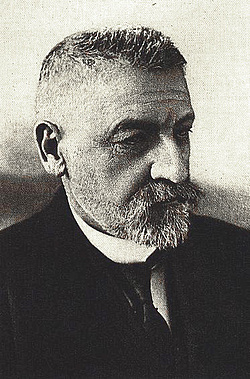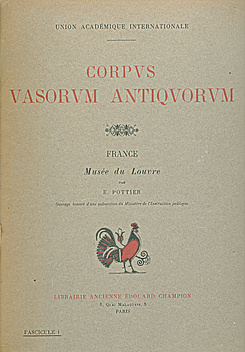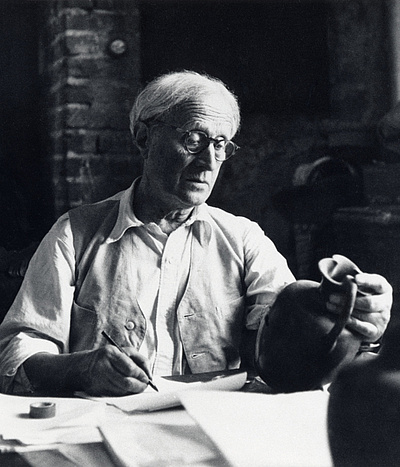An International Project
The Corpus Vasorum Antiquorum (CVA) became the first international project of the Union Académique Internationale (UAI), founded in 1919.

Initiator of the undertaking was Edmont Pottier, curator of the oriental antiquities and of ancient ceramics in the Louvre. In 1922, he presented the first volume of the series, which was supposed to publish the whole of ancient ceramics in museums and collections.
The project follows the tradition of the large text and inscription corpora of the 19th century and aims at making the complete collection of all sources available as basis for sound research. For a corpus of objects – even if they have painted decoration – an important precondition is the development of the means of photography and an appropriate photo printing.
Pottier himself had for the first time presented a photo catalogue of ancient vases in the Louvre, emphasising that every scientific assessment of a vase, should there be no other autopsy of the object possible, would require at least a trustable image: „Je me suis donné pour règle de ne jamais dècrire un vase sans renvoyer en même temps à une reproduction.“


In the first volumes of the new vase corpus, the focus was on the presentation of as many vessels as possible; thus, in the first fascicle on the Louvre, there are about 400 vessels documented.
The first CVA volume: Louvre 1 from 1922
Establishing a Research Tool
From theses beginnings, the corpus developed further, mirroring the changing priorities in vase studies. A defining role had John D. Beazley, who authored the first corpus volume on Oxford’s Ashmolean Museum in 1927.

While Edmont Pottier focussed on the general characteristics of a specific vessel production, in order to draw conclusions on the manufacturers’ culture, Beazley was highly interested in the classification of the painting and its attribution to specific painters. The overview panels of the early CVA volumes were not appropriate for such research. In the plates of his Oxford volumes, Beazley attached importance to illustrate the pictorial depictions and details of the painting, sometimes even skipping the image of the overall vessel shape.
Even the project’s research programme as a whole followed changing interests: Instead including ceramics of the entire Old World, the focus was directed towards painted Greek ceramics and the products influenced by them. As a side effect, this restriction provided the possibility to ever complete the project altogether. With Pottier’s broad objectives, it would probably never have been achieved.

The Corpus Vasorum in Germany
Having lost World War I, Germany initially was not a member of the UAI, and also not part of the corpus project. Only when joining the UAI in 1935, a participation was initiated.
At first, it was not clear if the German CVA section should be based in Berlin or in Munich, both cities having the largest Museums of ancient vases. Ultimately Ernst Buschor’s competence in vase research tipped the scale for Munich.
Being both professor for classical archaeology at Munich university and member of the academy, Buschor established an office at the Bavarian Academy of Sciences and Humanities. The German section of the CVA commenced work on April 1st, 1937.
Since that time, more than one hundred volumes have been published on the inventory of German museums and collections. In the beginning, the editors were in part employees of the museum, later they were mostly funded by the German Research Foundation.
Since 1980 the German CVA is a project under the umbrella of the Academies’ Programme coordinated by the Union of the German Academies of Sciences and Humanities. This way a funding is being secured which enables a swift and predictable proceeding of the project.
Literature
M. Bentz, Zur Geschichte des CVA, in: Vasenforschung und Corpus Vasorum Antiquorum. Standortbestimmung und Perspektiven, CVA Deutschland Beihefte 1 (München 2002) 9–15
D. Kurtz, A Corpus of Ancient Vases, Revue Archéologique 2004, 259–286 (see PDF)
P. Zanker – S. Schmidt, Antike Lebenswelten am Mittelmeer, Akademie Aktuell 2009, H. 2, 44–46 (see Akademie Aktuell)
Project Leaders
1937–1961 | Ernst Buschor (1886–1961), Archaeologist |
1962–1967 | Hans Möbius (1895–1977), Archaeologist |
1968–1987 | Emil Kunze (1901–1994), Archaeologist |
1987–2016 | Paul Zanker (*1937), Archaeologist |
Seit 2016 | Matthias Steinhart (*1966), Archaeologist |
Editors
1937–1962 | Adolf Greifenhagen |
1962–1966 | Dietrich Schulz |
1966–1999 | Heinrich B. Siedentopf |
1999–2004 | Martin Bentz |
2004–2005 | Ralf von den Hoff |
2005–2006 | Nicola Hoesch |
Since 2006 | Stefan Schmidt |

